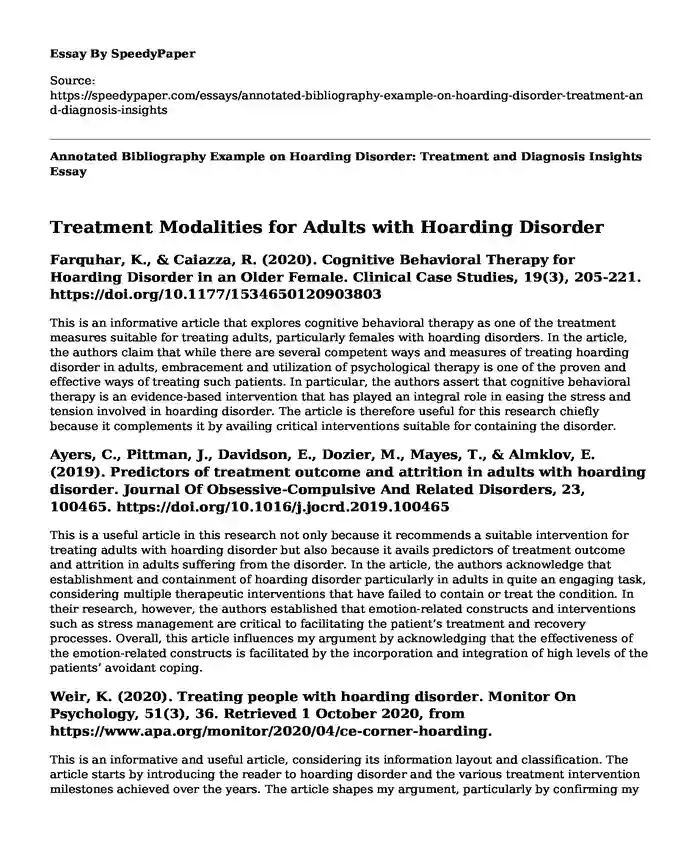
| Type of paper: | Essay |
| Categories: | Behavior Disorder Cognitive development |
| Pages: | 3 |
| Wordcount: | 735 words |
Treatment Modalities for Adults with Hoarding Disorder
Farquhar, K., & Caiazza, R. (2020). Cognitive Behavioral Therapy for Hoarding Disorder in an Older Female. Clinical Case Studies, 19(3), 205-221. https://doi.org/10.1177/1534650120903803
This is an informative article that explores cognitive behavioral therapy as one of the treatment measures suitable for treating adults, particularly females with hoarding disorders. In the article, the authors claim that while there are several competent ways and measures of treating hoarding disorder in adults, embracement and utilization of psychological therapy is one of the proven and effective ways of treating such patients. In particular, the authors assert that cognitive behavioral therapy is an evidence-based intervention that has played an integral role in easing the stress and tension involved in hoarding disorder. The article is therefore useful for this research chiefly because it complements it by availing critical interventions suitable for containing the disorder.
Ayers, C., Pittman, J., Davidson, E., Dozier, M., Mayes, T., & Almklov, E. (2019). Predictors of treatment outcome and attrition in adults with hoarding disorder. Journal Of Obsessive-Compulsive And Related Disorders, 23, 100465. https://doi.org/10.1016/j.jocrd.2019.100465
This is a useful article in this research not only because it recommends a suitable intervention for treating adults with hoarding disorder but also because it avails predictors of treatment outcome and attrition in adults suffering from the disorder. In the article, the authors acknowledge that establishment and containment of hoarding disorder particularly in adults in quite an engaging task, considering multiple therapeutic interventions that have failed to contain or treat the condition. In their research, however, the authors established that emotion-related constructs and interventions such as stress management are critical to facilitating the patient’s treatment and recovery processes. Overall, this article influences my argument by acknowledging that the effectiveness of the emotion-related constructs is facilitated by the incorporation and integration of high levels of the patients’ avoidant coping.
Weir, K. (2020). Treating people with hoarding disorder. Monitor On Psychology, 51(3), 36. Retrieved 1 October 2020, from https://www.apa.org/monitor/2020/04/ce-corner-hoarding.
This is an informative and useful article, considering its information layout and classification. The article starts by introducing the reader to hoarding disorder and the various treatment intervention milestones achieved over the years. The article shapes my argument, particularly by confirming my earlier research that while there exist multiple therapeutic interventions to treat the disorder, cognitive behavioral therapy is the appropriate and most effective intervention. Typically, by embracing cognitive behavioral therapy the victims of hoarding disorder experience a reduction in the symptoms while demonstrating a positive discard of hindering behaviors. Overall, this is an informative piece of information that will positively guide and influence the research process.
Diagnosis of Hoarding Disorder
Mataix-Cols, D., Frost, R., Pertusa, A., Clark, L., Saxena, S., & Leckman, J. et al. (2010). Hoarding disorder: a new diagnosis for DSM-V? Depression And Anxiety, 27(6), 556-572. https://doi.org/10.1002/da.20693
The article is useful in this research specifically because it explores quite a wide range of literature on the diverse ways of diagnosing hoarding disorder in adults. The articles start by asserting that some of the diagnostic interventions are interdependent implying that they can be used interchangeably based on the condition under review. In this case, the authors state that DSM-IV-TR is one of the best diagnostic interventions suitable for hoarding disorders. However, the authors state that based on the results generated, a clinician may consider using the criteria used to diagnose obsessive-compulsive disorder or obsessive-compulsive personality disorder.
Saljoughian, M. (2015). Hoarding Disorder: Diagnosis and Treatment. Medication Management, 40(11), 60-62. Retrieved 1 October 2020, from https://uspharmacist.com/article/hoarding-disorder-diagnosis-and-treatment.
This article is useful in this research chiefly because it outlines and breaks down hoarding disorder, including its signs, symptoms, and the various interventions suitable for treating the condition. In the article, the author states that while hoarding disorder is often used to diagnose obsessive-compulsive disorder, it can be independently diagnosed. However, the diagnosis process starts by understanding the key features defining the condition. Therefore, to diagnose hoarding disorder as the author documents, one needs to express signs and symptoms such as the existence of large clutter at the victim’s place of work or residence, loss of important items such as money, and inability to move furniture among other goods, and feeling overwhelmed by the goods one possesses. Overall, this article will help shape my argument in the research by providing critical information for the analysis.
Cite this page
Annotated Bibliography Example on Hoarding Disorder: Treatment and Diagnosis Insights. (2024, Jan 04). Retrieved from https://speedypaper.net/essays/annotated-bibliography-example-on-hoarding-disorder-treatment-and-diagnosis-insights
Request Removal
If you are the original author of this essay and no longer wish to have it published on the SpeedyPaper website, please click below to request its removal:
- A Literary Essay Sample with Kelly Cherry's Poem Analysis: Alzheimer's Disease
- Case Study Paper Example on Unipolar Depression
- Teamwork Reflection. Paper Example
- Essay Sample on Symptom: "They Make Me Mad."
- Paper Example: Multi-Agency Meeting
- Free Essay. Assessing and Treating Clients with Impulsivity, Compulsivity, and Addiction
- Laban/Bartenieff Movement Analysis Essay
Popular categories




